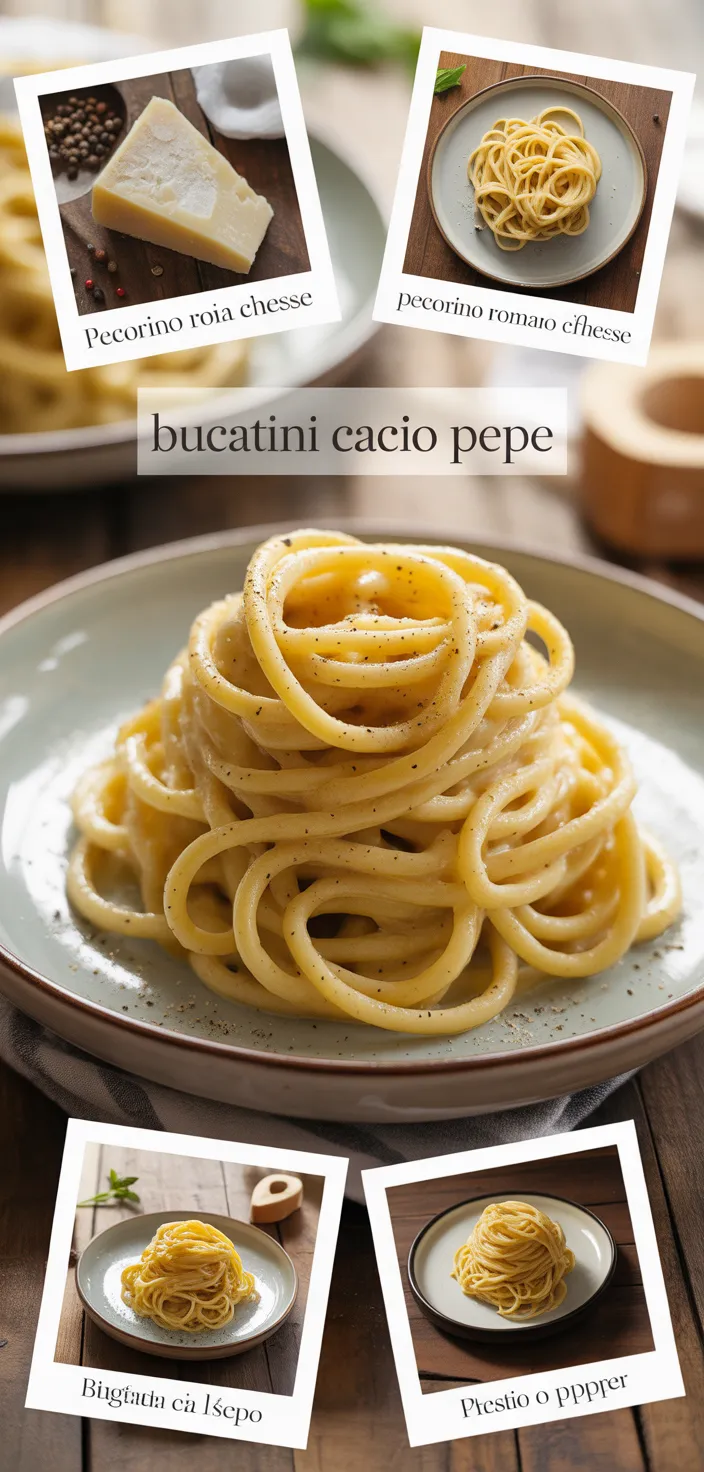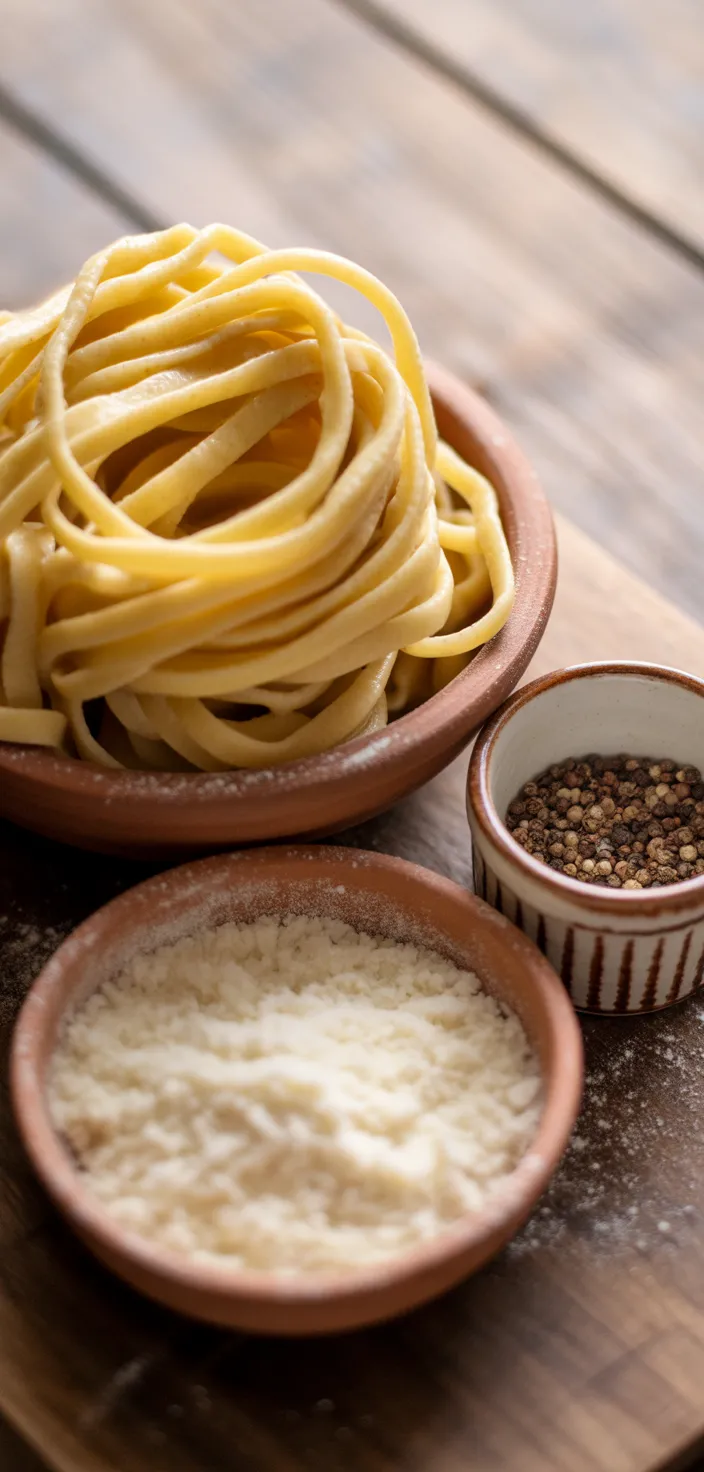I’m a professional food blogger and after testing timing and cheese-to-pasta ratios I’ve perfected an authentic Bucatini Cacio e Pepe with only the classic three ingredients, and in this Roman food guide I share foolproof tips for getting a creamy sauce without making a separate Cacio e Pepe sauce.

I used to call most Cacio e Pepe recipes Italian mac and cheese until I stubbornly learned the Roman way. Using bucatini and properly aged Pecorino Romano, I cracked the code for a silky, insanely simple plate that still shocks people when they try it.
This is not a shortcut it’s tradition and I don’t baby it. Expect sharp flavor, texture that clings to every strand, and a few foolproof tricks I swear by.
If you crave honest Roman Food and a Fool Proof Recipes approach to pasta, stick around, you might actually surprise yourself.
Ingredients

- Bucatini: Thick hollow pasta, mostly carbs for energy, little fiber, hearty and comfortingly chewy not sweet.
- Pecorino Romano: Sharp salty sheep’s cheese, rich in protein and calcium, its high in fat and sodium.
- Black pepper: Gives peppery heat and aromatic oils, contains tiny antioxidants, nearly zero calories though.
- Kosher salt: Pure sodium chloride, no calories but amplifies flavor, excess use may raise blood pressure.
- Pasta water: Starchy hot water helps bind cheese to pasta, adds seasoning and silky sauce body.
Ingredient Quantities
- 14 oz (400 g) bucatini, about 4 servings
- 1 1/3 cups (115 g) finely grated Pecorino Romano, packed aged 12 months or more
- 2 teaspoons freshly cracked black pepper
- 1 to 2 tablespoons coarse kosher salt for the pasta water
- About 6 quarts (5.7 L) cold water for boiling pasta
How to Make this
1. Bring about 6 quarts (
5.7 L) cold water to a rolling boil in a large pot, stir in 1 to 2 tablespoons coarse kosher salt, then add 14 oz (400 g) bucatini and cook until just shy of al dente, about 1 to 2 minutes less than package time; reserve 1 1/2 to 2 cups of the starchy pasta water before draining.
2. While the pasta cooks finely grate 1 1/3 cups (115 g) Pecorino Romano, packed and aged 12 months or more, and freshly crack 2 teaspoons black pepper into a bowl.
3. In a large wide skillet over medium heat toast the cracked pepper in the dry pan for about 1 minute until fragrant but not burned, shaking the pan often; this wakes up the oils and gives real flavor.
4. Add about 1/2 cup of the reserved hot pasta water to the toasted pepper in the skillet to bloom the pepper and loosen the pan, then turn the heat off or to very low so it stays hot but not boiling.
5. In a separate large bowl combine the grated Pecorino with 1/2 cup to 3/4 cup of the reserved hot pasta water and whisk or stir vigorously to make a smooth, thick slurry; add the water slowly so the cheese doesnt seize into clumps.
6. Drain the bucatini quickly but do not rinse, then add the pasta straight into the skillet with the pepper and give it a quick toss to coat and pick up starch.
7. Remove the skillet from direct heat and add the cheese slurry a little at a time while tossing the bucatini vigorously with tongs or two forks, adding more reserved pasta water as needed a tablespoon at a time until the sauce becomes glossy and clings to each strand.
8. If the sauce looks grainy or too thick keep tossing off heat and slowly add more hot pasta water until it smooths out; avoid heating the cheese too much or it will seize and get stringy.
9. Taste and adjust with a small sprinkle of extra Pecorino or a pinch more cracked pepper if needed, serve immediately in warm bowls and finish with extra Pecorino and pepper on top.
Equipment Needed
1. Large pot (6 qt or larger) for boiling the bucatini
2. Large wide skillet, heavy bottomed, for toasting pepper and finishing the sauce
3. Colander to drain the pasta quickly (dont rinse)
4. Microplane or fine box grater for the Pecorino
5. Tongs (or two forks) to toss the pasta and sauce
6. Heatproof measuring cup or ladle to reserve and add hot pasta water
7. Medium mixing bowl and a whisk or fork to make the cheese slurry
8. Pepper mill or mortar and pestle to crack the black pepper
FAQ
Bucatini Cacio E Pepe: Authentic Foolproof Recipe Substitutions and Variations
- Bucatini: swap for spaghetti or tonnarelli, both give a similar chew. If you use thinner spaghetti cook it a bit less so it stays al dente.
- Pecorino Romano: use Parmigiano Reggiano or Grana Padano if you dont have Pecorino. Parmesan is milder so add a tiny pinch more salt and taste as you go.
- Freshly cracked black pepper: use coarse ground black peppercorns or Tellicherry for more aroma, white pepper for a milder, cleaner heat. If you only have pre ground pepper use about 25 percent more.
- Coarse kosher salt for the pasta water: fine sea salt or table salt works, just reduce the volume because finer salt is denser. If you use table salt start with about half the spoonfuls and taste.
Pro Tips
1) Grate the Pecorino as fine as you can and let it sit at room temp for 5 to 10 minutes before you try to make the slurry. If grating is a pain, pop the block in the freezer for 10–15 minutes first, it firms up and grates cleaner; then let it warm a bit so it mixes better, otherwise the cheese can seize.
2) Toast the cracked pepper until you can really smell it, but dont let it burn. After toasting, crush a few bigger pieces by hand and toss them in at the end for little bursts of spice, they add texture and more aroma.
3) Build the emulsion slowly and off the heat, add the hot pasta water a tablespoon at a time while you toss or whisk vigorously. If the sauce goes grainy or starts to seize, stop heating, keep tossing and add more hot water; if that fails, finish the cheese in a separate bowl with hot water till silky then bring it back to the pasta.
4) Undercook the bucatini a minute or two, reserve way more starchy pasta water than you think you need, and use tongs to lift and toss the strands so each gets coated. Serve in warm bowls right away, cold bowls kill the sauce fast.

Bucatini Cacio E Pepe: Authentic Foolproof Recipe
I’m a professional food blogger and after testing timing and cheese-to-pasta ratios I’ve perfected an authentic Bucatini Cacio e Pepe with only the classic three ingredients, and in this Roman food guide I share foolproof tips for getting a creamy sauce without making a separate Cacio e Pepe sauce.
4
servings
480
kcal
Equipment: 1. Large pot (6 qt or larger) for boiling the bucatini
2. Large wide skillet, heavy bottomed, for toasting pepper and finishing the sauce
3. Colander to drain the pasta quickly (dont rinse)
4. Microplane or fine box grater for the Pecorino
5. Tongs (or two forks) to toss the pasta and sauce
6. Heatproof measuring cup or ladle to reserve and add hot pasta water
7. Medium mixing bowl and a whisk or fork to make the cheese slurry
8. Pepper mill or mortar and pestle to crack the black pepper
Ingredients
-
14 oz (400 g) bucatini, about 4 servings
-
1 1/3 cups (115 g) finely grated Pecorino Romano, packed aged 12 months or more
-
2 teaspoons freshly cracked black pepper
-
1 to 2 tablespoons coarse kosher salt for the pasta water
-
About 6 quarts (5.7 L) cold water for boiling pasta
Directions
- Bring about 6 quarts (
- 7 L) cold water to a rolling boil in a large pot, stir in 1 to 2 tablespoons coarse kosher salt, then add 14 oz (400 g) bucatini and cook until just shy of al dente, about 1 to 2 minutes less than package time; reserve 1 1/2 to 2 cups of the starchy pasta water before draining.
- While the pasta cooks finely grate 1 1/3 cups (115 g) Pecorino Romano, packed and aged 12 months or more, and freshly crack 2 teaspoons black pepper into a bowl.
- In a large wide skillet over medium heat toast the cracked pepper in the dry pan for about 1 minute until fragrant but not burned, shaking the pan often; this wakes up the oils and gives real flavor.
- Add about 1/2 cup of the reserved hot pasta water to the toasted pepper in the skillet to bloom the pepper and loosen the pan, then turn the heat off or to very low so it stays hot but not boiling.
- In a separate large bowl combine the grated Pecorino with 1/2 cup to 3/4 cup of the reserved hot pasta water and whisk or stir vigorously to make a smooth, thick slurry; add the water slowly so the cheese doesnt seize into clumps.
- Drain the bucatini quickly but do not rinse, then add the pasta straight into the skillet with the pepper and give it a quick toss to coat and pick up starch.
- Remove the skillet from direct heat and add the cheese slurry a little at a time while tossing the bucatini vigorously with tongs or two forks, adding more reserved pasta water as needed a tablespoon at a time until the sauce becomes glossy and clings to each strand.
- If the sauce looks grainy or too thick keep tossing off heat and slowly add more hot pasta water until it smooths out; avoid heating the cheese too much or it will seize and get stringy.
- Taste and adjust with a small sprinkle of extra Pecorino or a pinch more cracked pepper if needed, serve immediately in warm bowls and finish with extra Pecorino and pepper on top.
Notes
- Below you’ll find my best estimate of this recipe’s nutrition facts. Treat the numbers as a guide rather than a rule—great food should nourish both body and spirit. Figures are approximate, and the website owner assumes no liability for any inaccuracies in this recipe.
Nutrition Facts
- Serving Size: 229g
- Total number of serves: 4
- Calories: 480kcal
- Fat: 9g
- Saturated Fat: 5.2g
- Trans Fat: 0.1g
- Polyunsaturated: 0.6g
- Monounsaturated: 1.8g
- Cholesterol: 26mg
- Sodium: 520mg
- Potassium: 249mg
- Carbohydrates: 75g
- Fiber: 3g
- Sugar: 4g
- Protein: 21g
- Vitamin A: 100IU
- Vitamin C: 0mg
- Calcium: 270mg
- Iron: 2mg







